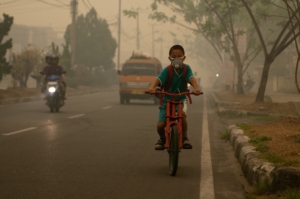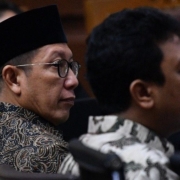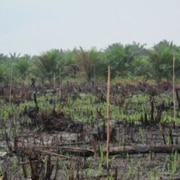
The Indonesian government is being urged to act on environmental protection as this year’s fire season shapes up to be the worst since the 2015 haze crisis. Photo by Aulia Erlangga/CIFOR.
As Indonesia’s haze crisis returned in September, pressure began mounting for newly re-elected President Joko Widodo to act on the environment. One sign of progress may be found in plans to provide incentives to subnational governments to protect the local environment.
In August this year, Sri Mulyani Indrawati — who has stayed on as finance minister in the president’s new Cabinet — announced plans for the national government to offer fiscal incentives to provinces with large forested areas to protect their natural assets. She also encouraged provinces to make a similar offer of incentives to districts.
According to the minister’s announcement, the ecological fiscal transfers would be made available based on performance, to reward provinces with large forested areas for protecting the environment and empowering traditional communities.
Two new mechanisms for the transfer of funds from provincial to district, and district to village governments have been developed since 2018. Known as TAPE (Transfer Anggaran Provinsi berbasis Ekologi, Provincial Ecological Fiscal Transfers) and TAKE (Transfer Anggaran Kabupaten berbasis Ekologi, District Ecological Fiscal Transfers), respectively, they are the product of collaboration between the Finance Ministry’s Fiscal Policy Agency, provincial and district governments, and a coalition of civil society organisations, including The Asia Foundation.
This is a significant development for Indonesia, where funding for environmental protection has been relatively scarce.
To date, only 0.3 per cent of total central government transfers to subnational governments have related to environmental protection. In fact, until last year, there were no ecological performance indicators for subnational governments to receive funds from the central government. Consequently, subnational government spending on environmental protection has also been low, averaging 1.1 per cent of spending by provinces, 1.3 per cent by districts and 3.5 per cent by municipalities so far this year.
The first areas to demonstrate the changes in action are North Kalimantan province and Jayapura district, which included TAPE and TAKE mechanisms, respectively, in regulations issued in February this year.
Why does it matter?
These developments are important for at least five reasons.
First, the regulations introduced in North Kalimantan province and Jayapura district are the first, to our knowledge, to enable transfers based on environmental protection, or performance-based incentives more generally, in Indonesia. North Kalimantan and Jayapura are pioneers in this respect.
Second, by making allocations based on the needs and performance of subnational governments, the new incentives have the potential to significantly improve the governance of provincial and district financial assistance schemes. In most regions, financial assistance schemes have not always been based on strong technical considerations. TAPE and TAKE promote transparent data and formulas that can be verified by any interested party.
Third, TAPE and TAKE promote more active participation by local governments in protecting the environment and so increase their contribution to various national agendas, such as Indonesia’s commitment to the Paris Agreement and the Low Carbon Development Indonesia initiative launched by the National Development Planning Agency (Bappenas). Under the Paris Agreement, Indonesia has pledged to reduce carbon emissions by 29 per cent by 2030, or 41 per cent with international support. The Bappenas initiative, launched in March this year, promotes environmental sustainability, resource efficiency, and social equity, in addition to economic growth.
Fourth, the schemes will strengthen partnerships between provincial and district governments, as well as between district and village governments. Until now, high levels of autonomy and direct transfers from the central government to the districts and villages have diminished the power of provincial and district governments to coordinate to pursue common development agendas.
Fifth, the new subnational regulations in North Kalimantan and Jayapura set precedents for the implementation of TAPE and TAKE that can be adjusted and adopted by other provinces and districts in Indonesia. Civil society organisations are now working with provincial and local governments in Papua, West Papua, East Kalimantan, Riau, and Aceh to formulate suitable TAPE and TAKE schemes for each locality.
TAPE in North Kalimantan
In February this year, North Kalimantan, Indonesia’s “youngest” province, issued a regulation on provincial financial assistance for districts that includes the TAPE scheme.
In partnership with local civil society organisations, the provincial government identified 17 performance indicators for the transfer of funds, grouped under five criteria: prevention and management of forest fires, green open space, waste management, water resource protection, and air pollution management. An overall index is calculated by weighted averaging of the district’s scores for the five criteria. Once received, the TAPE funds can only be used for activities supporting the five criteria above.
Before the introduction of the new regulation, the North Kalimantan government had been relatively advanced in operating the financial assistance scheme. Provincial regulations clearly define the objectives of financial assistance to reduce fiscal and development inequalities among the districts in the province. The new regulation basically expands the scope of the financial assistance scheme to include TAPE.
TAKE in Jayapura
In Indonesia’s easternmost province, Papua, the district of Jayapura has likewise issued a regulation on the village allocation funds, also in February this year, that includes the TAKE scheme.
The new regulation allows for four types of village-level allocations: basic, proportional, affirmative, and performance-based. The latter, which includes TAKE, is assessed using an existing Village Development Index (IDM) — a composite index of social, economic, and environmental subindices.
It is also important to note that the affirmative allocation of the village funds is designed to support recognition of customary (adat) villages and forests, with the aim of supporting acknowledgement of adat communities and their management of forests — an initiative expected to better protect forests.
Previously, the local government of Jayapura allocated village funds mainly on the basis of basic allocations (evenly distributed among villages) and proportional allocations (based on the needs of the villages). The new regulation introduces affirmative and performance incentive components into the formula.
Scaling up
The new incentives have the potential to encourage better environmental protection across Indonesia. Other provinces and districts must follow the example set by North Kalimantan and Jayapura to include these mechanisms in subnational regulations. Their pioneering efforts may also help the Ministry of Finance as it formulates a new Environmental Protection Fund, announced by the minister in August. Overall, the changes can provide better funding for environmental protection and, hopefully, better outcomes for the environment.
By putting funds into local hands, the new incentives also have the potential to fulfil the re-elected president’s pledge to develop Indonesia “from the peripheries”, getting government funds to remote regions where they are needed most.
With observers now closely watching the national government’s performance on environmental issues, we can also expect closer scrutiny of the movement of these funds. This should certainly help put pressure on subnational governments to ensure they are put to good use.










